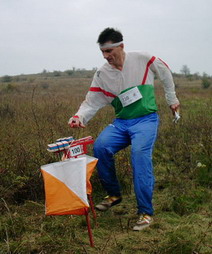Orienteering
Orienteering is a sport that combines running with navigation. It is a timed race in which individual participants use a map and a compass to navigate through unfamiliar terrain and visit a series of checkpoints, known as controls, in the correct order. The sport was developed in Sweden in the late 19th century and has since spread worldwide. Orienteering can take place in a variety of outdoor environments, including forests, urban areas, and mountains.
History[edit | edit source]
The origins of orienteering are traced back to the late 1800s in Sweden, where it was initially a military exercise. The first civilian orienteering competition took place in Norway in 1897. The sport quickly grew in popularity in the Nordic countries and then spread across Europe and to other continents. The International Orienteering Federation (IOF), established in 1961, is the governing body for the sport. Today, orienteering is practiced in over 75 countries around the world.
Types of Orienteering[edit | edit source]
There are several variations of orienteering, each requiring different sets of skills:
- Foot Orienteering: The most common form, where participants run through a course.
- Mountain Bike Orienteering: Participants navigate through a series of checkpoints using mountain bikes.
- Ski Orienteering: Conducted on snow, participants use skis to move between controls.
- Trail Orienteering: Designed for participants with limited mobility, focusing on the accuracy of navigation rather than speed.
Equipment[edit | edit source]
The essential equipment for orienteering includes:
- A detailed, topographical map specific to the orienteering event.
- A compass, used for navigation.
- Sport Ident (SI) card or Emit card, for electronic checking-in at control points.
Skills and Techniques[edit | edit source]
Successful orienteering requires a blend of physical and mental skills. Participants must be able to read and interpret maps quickly, make navigation decisions on the move, and possess the physical ability to travel through challenging terrain. Key techniques include:
- Map reading: Understanding topographical symbols and translating them to the real world.
- Route choice: Deciding the fastest or most efficient path between controls.
- Compass use: Navigating straight lines or setting bearings in complex environments.
Competitions and Events[edit | edit source]
Orienteering events range from local meets to international competitions. The World Orienteering Championships (WOC) is the premier event, attracting competitors from around the globe. Other significant events include the World Cup in Orienteering, Junior World Championships, and various national championships.
Popularity and Cultural Impact[edit | edit source]
Orienteering has a dedicated following and is particularly popular in Nordic countries, Central Europe, and the United Kingdom. It is recognized as a unique sport that promotes both physical fitness and environmental appreciation. Orienteering events often take place in natural settings, emphasizing the importance of conservation and respect for the outdoors.
See Also[edit | edit source]
Search WikiMD
Ad.Tired of being Overweight? Try W8MD's physician weight loss program.
Semaglutide (Ozempic / Wegovy and Tirzepatide (Mounjaro / Zepbound) available.
Advertise on WikiMD
|
WikiMD's Wellness Encyclopedia |
| Let Food Be Thy Medicine Medicine Thy Food - Hippocrates |
Translate this page: - East Asian
中文,
日本,
한국어,
South Asian
हिन्दी,
தமிழ்,
తెలుగు,
Urdu,
ಕನ್ನಡ,
Southeast Asian
Indonesian,
Vietnamese,
Thai,
မြန်မာဘာသာ,
বাংলা
European
español,
Deutsch,
français,
Greek,
português do Brasil,
polski,
română,
русский,
Nederlands,
norsk,
svenska,
suomi,
Italian
Middle Eastern & African
عربى,
Turkish,
Persian,
Hebrew,
Afrikaans,
isiZulu,
Kiswahili,
Other
Bulgarian,
Hungarian,
Czech,
Swedish,
മലയാളം,
मराठी,
ਪੰਜਾਬੀ,
ગુજરાતી,
Portuguese,
Ukrainian
Medical Disclaimer: WikiMD is not a substitute for professional medical advice. The information on WikiMD is provided as an information resource only, may be incorrect, outdated or misleading, and is not to be used or relied on for any diagnostic or treatment purposes. Please consult your health care provider before making any healthcare decisions or for guidance about a specific medical condition. WikiMD expressly disclaims responsibility, and shall have no liability, for any damages, loss, injury, or liability whatsoever suffered as a result of your reliance on the information contained in this site. By visiting this site you agree to the foregoing terms and conditions, which may from time to time be changed or supplemented by WikiMD. If you do not agree to the foregoing terms and conditions, you should not enter or use this site. See full disclaimer.
Credits:Most images are courtesy of Wikimedia commons, and templates, categories Wikipedia, licensed under CC BY SA or similar.
Contributors: Prab R. Tumpati, MD




